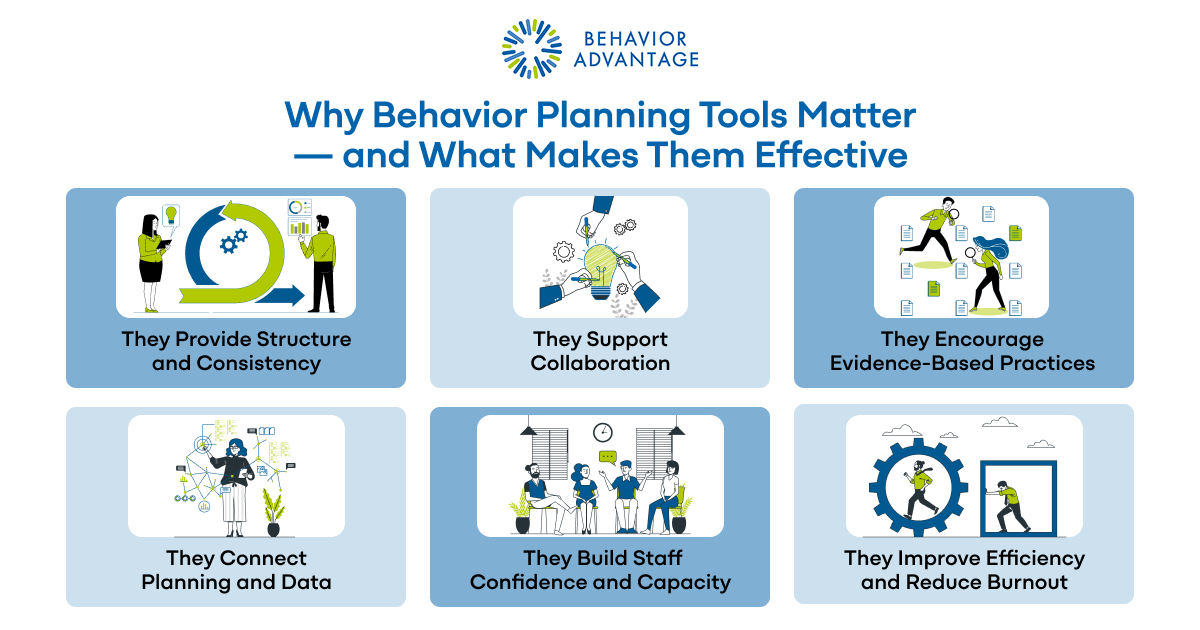Supporting student behavior in schools takes more than good instincts, it requires a structured, collaborative approach rooted in thoughtful planning. If you’ve ever developed a Behavior Intervention Plan (BIP), whether as a school psychologist, behavior specialist, special education teacher, or administrator, you know how complex the process can be, especially when a student needs more targeted support.
So where do you begin?
A behavior planning tool can provide that starting point – and much more.
Whether it’s a template, checklist, or software platform, a behavior planning tool acts as a roadmap to guide your team from assessment to action. It prompts essential steps, keeps everyone aligned, and ensures that strategies are both evidence-based and student-centered. By reducing guesswork and bringing structure to the process, these tools help teams respond to challenging behavior with greater clarity, consistency, and confidence.
Defining a Behavior Planning Tool
A behavior planning tool is a template, form, or software platform designed to support school teams in the systematic development and implementation of behavior support plans, including Behavior Intervention Plans (BIPs). It ensures the planning process is:
- Functional (focused on the “why” behind behavior)
- Individualized (tailored to a student’s specific needs)
- Data-informed (based on observations, assessments, and trends)
- Collaborative (engaging multiple team members)
- Sustainable (easy to revisit and revise)
Just as educators rely on IEP templates or curriculum frameworks, behavior teams benefit from having structured tools that support best practices in behavior planning and intervention.
Curious about the distinction between behavior support plans and BIPs? Learn more in this article.
Why Behavior Planning Tools Matter—and What Makes Them Effective
Behavior planning tools aren’t just paperwork—they’re essential for developing plans that lead to real, measurable change. Here’s why they matter and what sets the best tools apart:
✅ They Provide Structure and Consistency
A well-designed tool ensures key components of a BIP aren’t overlooked. It walks teams through every step—from defining the behavior to designing strategies and tracking progress.
✅ They Support Collaboration
With multiple people involved in plan development and implementation, shared tools help align language, expectations, and responsibilities.
✅ They Encourage Evidence-Based Practices
Effective tools incorporate prompts or strategy banks that guide teams toward interventions grounded in behavioral science.
Need ideas for research-based interventions? Download this free list of 20 Essential Behavior Intervention Strategies (PDF).
✅ They Connect Planning and Data
The best tools go beyond writing a plan—they support data collection and analysis, making it easier to adjust based on results.
✅ They Build Staff Confidence and Capacity
When educators have access to user-friendly tools, they better understand the purpose behind each component—and implement plans with greater fidelity.
✅ They Improve Efficiency and Reduce Burnout
Instead of reinventing the wheel or navigating disorganized systems, teams can streamline documentation, saving valuable time and energy.
When integrated into digital platforms, these benefits are amplified. Tools like Behavior Advantage offer searchable documentation, real-time collaboration, and built-in dashboards for data and plan tracking—making behavior support scalable and sustainable across schools and districts.
For a quick-start solution, download the Behavior Intervention Plan Template, which walks teams through prevention, skill-building, and collaboration.

How Behavior Planning Tools Improve Your BIP
A strong Behavior Intervention Plan (BIP) is more than a document—it’s a roadmap for meaningful behavior change. Behavior planning tools help school teams develop BIPs that are not only comprehensive and functional, but also easier to create, implement, and adjust over time.
Here’s how the right tool can enhance the key components of your BIP:
- Student Information and Background
Tools help organize relevant student details—such as grade level, learning needs, and behavior history—so teams start with the right context.
- Clear Identification and Definition of Target Behavior
Prompts and guided fields ensure the behavior is described in observable, measurable terms, reducing ambiguity and increasing consistency across staff.
- Prevention Strategies
Built-in strategy banks and drop-down menus help teams select proactive supports based on behavior function and context, streamlining the planning process.
- Replacement Behaviors
Tools guide teams to choose replacement skills that serve the same purpose as the target behavior, ensuring the new behavior is both functional and teachable.
- Teaching, Prompting, and Reinforcement Plan
Structured templates help define how and when new skills will be taught, prompted, and reinforced—making it easier for educators to implement with fidelity.
- Response Strategies
Clearly documented adult responses ensure consistency across staff and reduce the risk of inadvertently reinforcing challenging behavior.
By using a planning tool that walks teams through these components, your BIP becomes easier to develop, more aligned with best practices, and better positioned to result in real behavior change.
Want to see what this looks like in action? Explore real Behavior Intervention Plan examples for inspiration.
Types of Behavior Planning Tools
School teams may use a range of tools depending on their preferences, resources, and workflows. Common types include:
1. Paper-Based Templates
These help teams document plan components step-by-step. They’re widely used but often require manual data entry and are not ideal for updates or collaboration.
2. Fillable PDFs or Shared Documents
Tools like Google Docs offer better accessibility and team collaboration but are still limited when it comes to automation, analysis, and scalability.
3. Software Platforms
Digital tools specifically built for behavior planning. These platforms often include:
- Guided workflows aligned with FBA and BIP best practices
- Embedded strategy banks and intervention libraries
- Built-in data collection and graphing
- Secure student dashboards and reports
- Progress monitoring tied directly to intervention goals
Platforms like Behavior Advantage simplify the process of creating and managing plans while improving fidelity, collaboration, and data use.
Watch “The Three Essential Questions Behind Every Great BIP” to see how behavior planning tools can streamline the process to help your team turn insight into action.
Using a Behavior Planning Tool to Drive Real Behavior Change
The goal of any behavior plan is real, measurable improvement in a student’s ability to thrive socially, emotionally, and academically. But to achieve that, the plan must be more than just documentation. It needs to be practical, individualized, and consistently implemented.
Behavior Advantage was built with this exact goal in mind—to help school teams not only develop effective behavior intervention plans (BIPs), but to implement them successfully in real classroom settings. By combining evidence-based structure, functional assessment tools, and embedded progress monitoring, Behavior Advantage turns plans into action.
A high-quality behavior planning tool drives meaningful change by:
- Making planning practical and efficient, so educators spend less time navigating complex forms and more time supporting students
→ Behavior Advantage streamlines the planning process with intuitive software, built-in guidance, and practical data tools, helping teams complete plans efficiently without sacrificing quality.
- Helping teams understand behavior in context and plan by function, guiding them to identify why a behavior is occurring, examine triggers and patterns, and select strategies that address the root cause
→ Behavior Advantage helps educators think functionally about behavior at every level of the assessment continuum – from built-in tools that guide team discussion to a comprehensive Functional Behavior Assessment (FBA) template. The platform supports clear documentation of antecedents, consequences, and hypothesized function, and seamlessly links those insights into the Behavior Intervention Plan (BIP).
- Connecting teams with evidence-based strategies, so intervention efforts are grounded in approaches that work
→ With a curated library of strategies organized by behavior function, Behavior Advantage helps staff match appropriate interventions to student needs with confidence.
- Promoting consistent implementation, with clear plans for teaching skills, prompting replacement behaviors, and responding to challenges
→ Behavior Advantage structures each section of the BIP to clarify proactive strategies, adult responses, skill-teaching routines – ensuring everyone on the team is aligned. Each plan is also paired with an automatically generated Implementation Checklist to support fidelity, helping staff carry out the plan consistently across settings.
- Embedding progress monitoring tools, so teams can track behavior change over time, evaluate what’s working, and adjust support when needed
→ The platform includes integrated data tools that track student progress, generate graphs, and support data-informed decision making in real time.
When a behavior planning tool is user-friendly, aligned with best practices, and designed for real classrooms, it becomes more than just a place to write plans—it becomes a foundation for effective support and lasting behavior change.
Final Thoughts
Behavior challenges in schools can be complex—but behavior planning doesn’t have to be. With the right tools, school teams can create behavior intervention plans that are focused, functional, and effective.
Whether your goal is to build stronger plans, streamline collaboration, or monitor student progress over time, a behavior planning tool provides the structure and support you need to do the work well.
Behavior Advantage is a leading example of an effective behavior planning tool. It combines structured plan development, integrated data tracking, and implementation support in one intuitive platform built specifically for school-based behavior teams.
Ready to see how Behavior Advantage can help your school or district streamline your behavior planning process?









